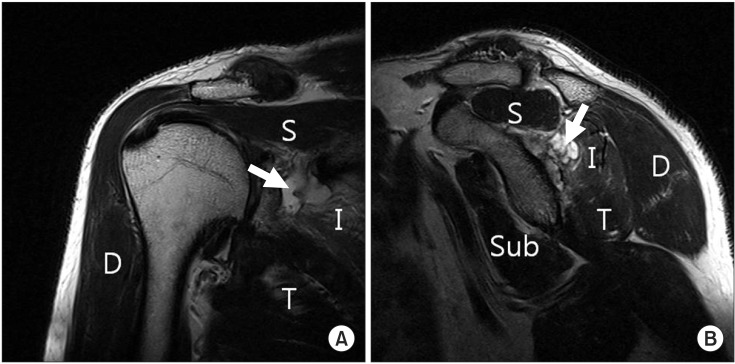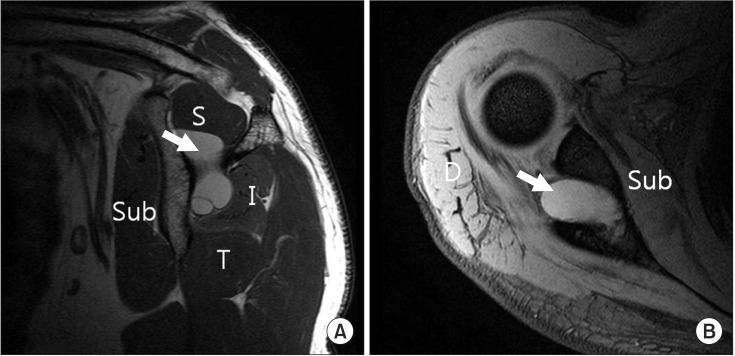Ann Rehabil Med.
2015 Oct;39(5):848-852. 10.5535/arm.2015.39.5.848.
Type 2 Superior Labral Anterior to Posterior Lesion-Related Paralabral Cyst Causing Isolated Infraspinatus Paralysis: Two Case Reports
- Affiliations
-
- 1Department of Rehabilitation Medicine, Jeju National University Hospital, Jeju National University School of Medicine, Jeju, Korea. clearblue10@naver.com
- 2Department of Orthopaedic Medicine, Jeju National University Hospital, Jeju National University School of Medicine, Jeju, Korea.
- KMID: 2148219
- DOI: http://doi.org/10.5535/arm.2015.39.5.848
Abstract
- Type 2 superior labral anterior to posterior (SLAP) lesion is a common cause of shoulder pain requiring surgical operation. SLAP tears are often associated with paralabral cysts, but they rarely cause nerve compression. However, we experienced two cases of type 2 SLAP-related paralabral cysts at the spinoglenoid notch which were confirmed as isolated nerve entrapment of the infraspinatus branch of the suprascapular nerve by electrodiagnostic assessment and magnetic resonance imaging. In these pathological conditions, comprehensive electrodiagnostic evaluation is warranted for confirmation of neuropathy, while surgical decompression of the paralabral cyst combined with SLAP repair is recommended.
MeSH Terms
Figure
Reference
-
1. Bencardino JT, Beltran J, Rosenberg ZS, Rokito A, Schmahmann S, Mota J, et al. Superior labrum anterior-posterior lesions: diagnosis with MR arthrography of the shoulder. Radiology. 2000; 214:267–271. PMID: 10644135.2. Knesek M, Skendzel JG, Dines JS, Altchek DW, Allen AA, Bedi A. Diagnosis and management of superior labral anterior posterior tears in throwing athletes. Am J Sports Med. 2013; 41:444–460. PMID: 23172004.
Article3. Chen AL, Ong BC, Rose DJ. Arthroscopic management of spinoglenoid cysts associated with SLAP lesions and suprascapular neuropathy. Arthroscopy. 2003; 19:E15–E21. PMID: 12861219.
Article4. Cummins CA, Messer TM, Nuber GW. Suprascapular nerve entrapment. J Bone Joint Surg Am. 2000; 82:415–424. PMID: 10724234.
Article5. Fehrman DA, Orwin JF, Jennings RM. Suprascapular nerve entrapment by ganglion cysts: a report of six cases with arthroscopic findings and review of the literature. Arthroscopy. 1995; 11:727–734. PMID: 8679037.
Article6. Tirman PF, Feller JF, Janzen DL, Peterfy CG, Bergman AG. Association of glenoid labral cysts with labral tears and glenohumeral instability: radiologic findings and clinical significance. Radiology. 1994; 190:653–658. PMID: 8115605.
Article7. Piatt BE, Hawkins RJ, Fritz RC, Ho CP, Wolf E, Schickendantz M. Clinical evaluation and treatment of spinoglenoid notch ganglion cysts. J Shoulder Elbow Surg. 2002; 11:600–604. PMID: 12469086.
Article
- Full Text Links
- Actions
-
Cited
- CITED
-
- Close
- Share
- Similar articles
-
- Multidirectional Instability Accompanying an Inferior Labral Cyst
- Paralabral Cyst of the Hip Compressing Common Femoral Vein Treated with Sono-guided Cyst Aspiration Followed by Arthroscopic Labral Debridement: A Case Report
- Superior Labrum Anterior to Posterior Lesion Type II with Accompanied Findings: Assessment of Shoulder MR Arthrographic Findings
- Paralabral Cysts and Their Correlation with Acetabular Disorder
- Compressive Partial Neuropathy of Axillary Nerve Resulting from Antero-Inferior Paralabral Cyst in an Adolescent Overhead Athlete



